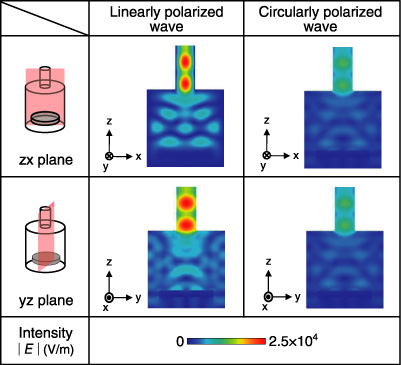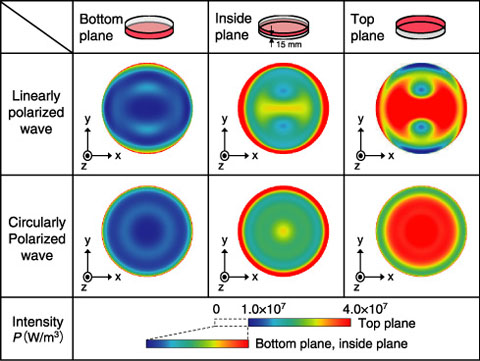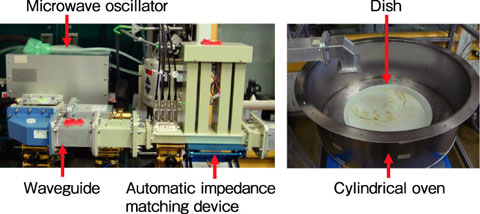
Fig.1-20 Electric field distribution in cylindrical oven

Fig.1-21 Absorbed power distribution of Pu-U mixed nitrate model in horizontal plane

Fig.1-22 Microwave heating equipment for mass production
In the mixed oxide (MOX) fuel fabrication process for a fast breeder reactor, Pu-U mixed nitrate solution, which is recovered through a reprocessing process, is heated in a microwave oven to produce a denitrate cake of MOX powder.
A turntable is used to obtain a uniform MOX raw cake, but it degrades the microwave heating efficiency by transferring heat to the outside of the oven. In order to reduce the heat loss, a method to rotate the electric field distribution, instead of the physical rotation of the cake, is investigated. To realize a rotational electric field, it is necessary to control the polarization of the microwaves.
The circularly polarized wave is a synthetic wave obtained by superimposing two linearly polarized waves that are mutually orthogonal and out of phase by 90°. It exhibits an excellent ability to uniform the electric field distribution.
In order to evaluate the behavior of the circularly polarized wave and the heating characteristics of the microwave heating equipment, electromagnetic analysis is performed by simulating the cylindrical oven with a circular waveguide. The Finite Difference Time Domain (FDTD) method is used with a frequency of 2.45 GHz and a power of 1 kW to evaluate the electric field distribution and absorbed power distribution of a target object.
The electric field distributions of linearly polarized and circularly polarized waves in the cylindrical oven are shown in Fig.1-20. The electric field distributions for the circularly polarized wave were more uniform compared to those for the linearly polarized wave.
The absorbed power distributions of the solid-state Pu-U mixed nitrate model in the horizontal plane are shown in Fig.1-21. In the case of the circularly polarized wave realized more symmetric and uniformity at the all planes than the linearly polarized wave.
From the results of the simulations, it is expected that the heating uniformity and efficiency can be improved by controlling the polarization of the microwaves.
In the near future, the developmental state of the circularly polarized wave will be determined using the equipment shown in Fig.1-22. Experiments to confirm the heating uniformity of a solution will be carried out in the next stage.